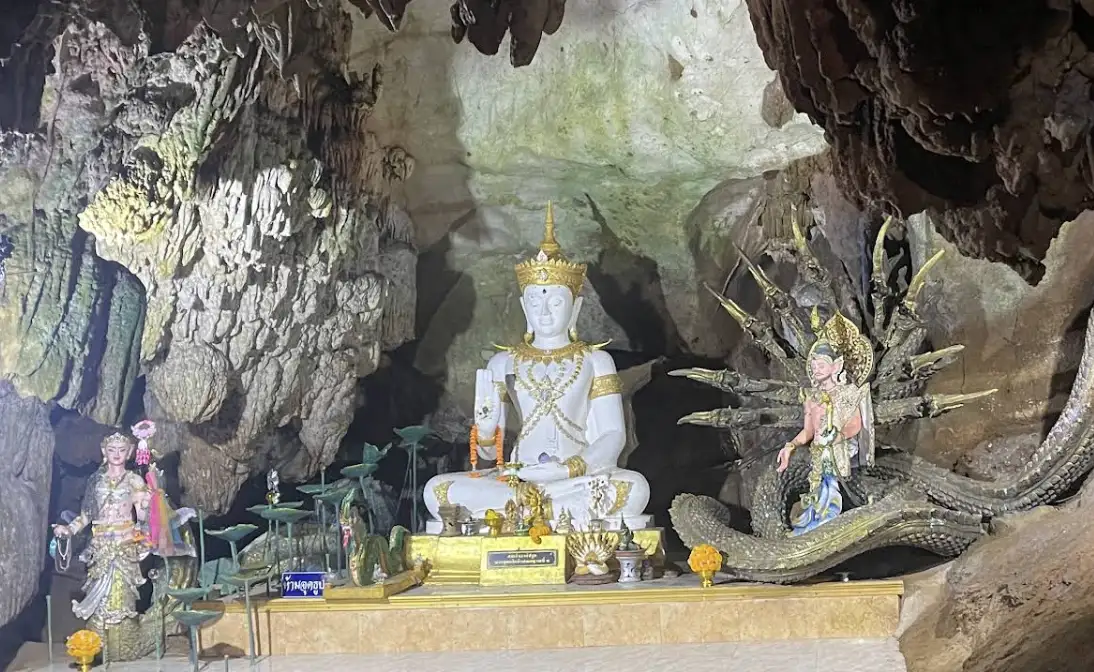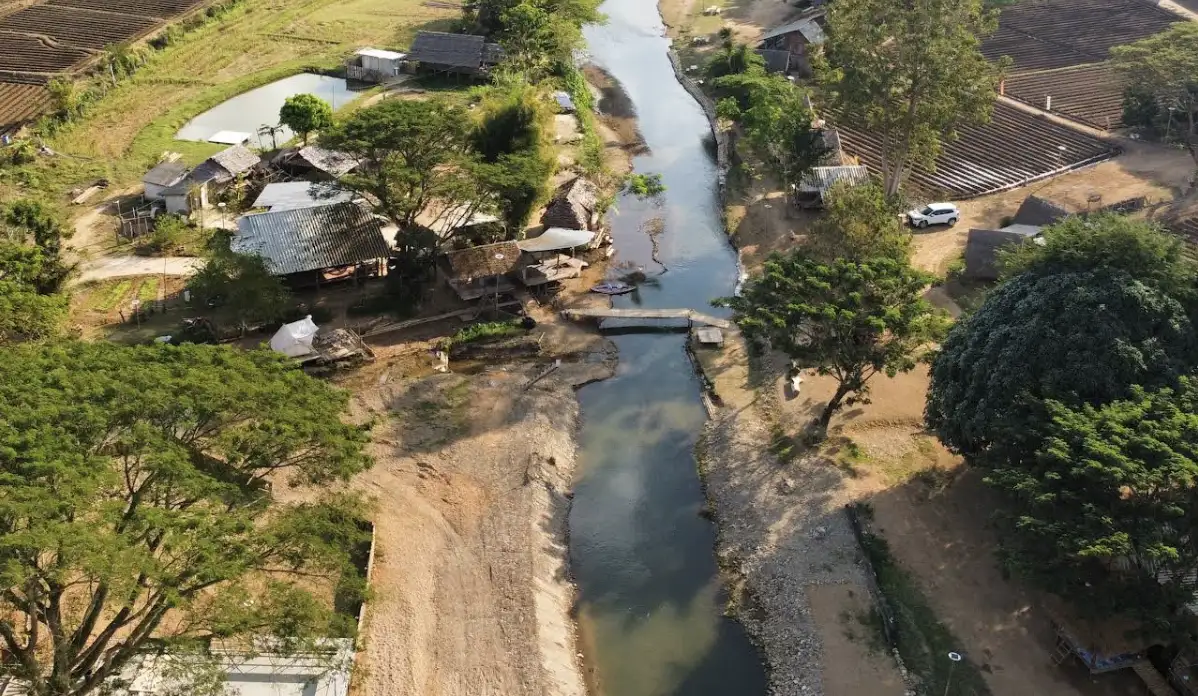Table of Contents
Nestled in the misty mountains of Chiang Mai Province, Chiang Dao is the kind of place that feels like a secret whispered by nature. About 1.5 hours north of Chiang Mai, this quiet district is home to towering peaks, sacred caves, lush jungles, and a laid-back vibe that’s perfect for travelers seeking adventure and serenity. My recent trip to Chiang Dao was a refreshing blend of exploration and relaxation, from hiking misty trails to marveling at ancient caves. Here’s my heartfelt review of Chiang Dao’s best spots, written as a traveler eager to share the magic of this hidden gem.
Getting There: The Scenic Drive
The journey to Chiang Dao set the tone for the trip. I rented a motorbike in Chiang Mai (300 THB/day, about $9 USD) for the 70-km ride, which was a thrill on the winding roads of Highway 107. The scenery shifted from urban sprawl to rice paddies and forested hills, with Doi Chiang Dao’s jagged peaks looming in the distance. If biking isn’t your thing, private drivers (1,500-2,000 THB/day) or shared songthaews (around 150 THB) are solid options. I stopped at a roadside café for a 30 THB iced coffee and some sticky rice snacks, chatting with the vendor about local life. Pro tip: Fill up on gas in Chiang Mai, as stations are sparse closer to Chiang Dao.
Chiang Dao Cave: A Mystical Underground World
The Chiang Dao Cave (Tham Chiang Dao) was my first stop, and it felt like stepping into a sacred underworld. Located at the base of Doi Chiang Dao, this limestone cave system is both a natural wonder and a spiritual site. The entry fee is 40 THB (about $1.20 USD), with an optional 100 THB for a guided lantern tour to deeper chambers. I opted for the guide, a local woman named Noi, who carried a kerosene lamp and shared stories about the cave’s Buddhist significance.

The main chamber, Tham Pha Plong, is illuminated and easy to navigate, with stalactites dripping from the ceiling and small Buddha statues tucked into alcoves. The air was cool and damp, a relief from the midday heat. The deeper sections, like Tham Maa, were narrower and more adventurous, with eerie rock formations that sparked my imagination. It took about 45 minutes to explore, and I loved the mix of natural beauty and spiritual calm. Wear sturdy shoes, as the paths can be slippery, and bring a small flashlight if you want to explore unguided areas.
Doi Chiang Dao: Hiking the Roof of Chiang Mai
Doi Chiang Dao, Thailand’s third-highest peak at 2,175 meters, is a hiker’s dream. I tackled the Kiew Pha Wok Trail, a challenging 7-km round-trip trek that took about 6 hours. The trailhead is near the cave, and you’ll need a local guide (500 THB per group) due to the trail’s remoteness. My guide, a Shan villager named Lek, was a wealth of knowledge, pointing out rare orchids and gibbon calls in the distance.
The ascent was steep at times, with dense jungle giving way to grassy ridges and jaw-dropping views. At the summit, I was rewarded with a 360-degree panorama of misty mountains and valleys. The cool November air (around 15°C/59°F) was perfect, though I’d packed a light jacket for the wind. The trail can be tough, especially after rain, so bring proper hiking shoes and plenty of water. Camping at the summit is an option (permits required), and I’m already planning to return for a starry night under the peaks. Note: The trail is closed during the rainy season (June-October) for safety.
Hot Springs: A Soothing Retreat
After hiking, the Pong Arng Hot Springs were a godsend. Tucked in a quiet valley, these natural springs are less touristy than others in Chiang Mai. The entry fee is 20 THB, and the pools are clean, with temperatures ranging from warm to piping hot (38-42°C). I soaked for an hour, letting the mineral-rich water ease my sore muscles while surrounded by greenery. There’s a small stream nearby for cooling off, and I saw locals boiling eggs in the hottest pools—a quirky touch. Bring a towel and swimsuit, and avoid peak hours (midday) for a quieter experience. Nearby stalls sell coconut water (30 THB) and grilled corn, perfect for a post-soak snack.
Wat Tham Pha Plong: A Spiritual Climb
The Wat Tham Pha Plong, a forest temple perched on a hillside, was a serene surprise. Reaching it requires climbing 510 stone steps through dense jungle, which took about 15 minutes but felt meditative with the sound of birds and rustling leaves. At the top, a golden chedi and small cave shrine offered a peaceful spot for reflection. I met a monk who shared tea and spoke about the temple’s history, built to honor a revered abbot. The views of the surrounding mountains were stunning, especially at sunset when the sky turned golden. Entry is free, but donations are appreciated. Wear modest clothing (shoulders and knees covered) out of respect.
Local Villages and Markets: Cultural Charm
Exploring Chiang Dao’s villages was a highlight for its authentic glimpse into rural life. I visited a Lahu village near Ban Muang Khong, where locals welcomed me with shy smiles and offered handmade textiles. I bought a woven bag for 150 THB, knowing it supported the community.

The weekly Tuesday morning market in Chiang Dao town was a vibrant scene, with stalls selling fresh produce, spicy som tam, and grilled pork skewers (20 THB each). I loved the energy—locals bargaining, kids running around, and the smell of lemongrass in the air. Be respectful when visiting villages: ask before taking photos and avoid treating them like tourist exhibits.
Practical Tips for Visiting Chiang Dao
Best Time to Visit: November to February offers cool, dry weather (10-20°C at higher elevations). March to May is hot, and June to October brings rain, making trails muddy and some areas inaccessible.
Getting Around: A motorbike is ideal for flexibility, but hire a driver if you’re not comfortable on winding roads. Local songthaews connect major sites but run on loose schedules.
What to Bring: Hiking shoes, a light jacket, insect repellent, sunscreen, and cash (many vendors don’t take cards). A reusable water bottle is a must for treks.
Where to Eat: Try Chiang Dao Nest for Western-Thai fusion (their green curry pasta is amazing, ~150 THB) or roadside stalls for khao soi (50 THB). The night market near the bus station has cheap, tasty options.
Where to Stay: I stayed at Malee’s Nature Lovers Bungalows (800 THB/night), a cozy spot with mountain views and friendly hosts. Homestays in villages are cheaper (300-500 THB) and immersive.
Respect the Environment: Stick to trails, don’t litter, and choose ethical operators for tours or treks to support conservation and local communities.
Final Thoughts
Chiang Dao is a destination that captures your heart with its raw beauty and quiet charm. From the mystical depths of its caves to the exhilarating heights of its peaks, every moment felt like a connection to something ancient and untouched. The warmth of the locals, the crisp mountain air, and the sense of discovery made it a standout in my Thailand travels. Compared to busier spots like Pai or Chiang Rai, Chiang Dao feels more intimate, like a place that hasn’t yet been fully discovered.
If you’re craving adventure, nature, or a moment to slow down, Chiang Dao delivers. I left with a camera full of photos, a heart full of memories, and a promise to return—maybe for a night camping under the stars. Pack your curiosity, embrace the journey, and let Chiang Dao weave its spell on you.

